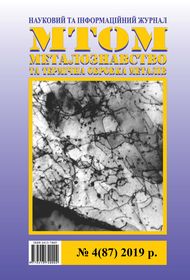Influence of texture on mechanical properties of titanium alloy tubes
DOI:
https://doi.org/10.30838/J.PMHTM.2413.241219.16.596Keywords:
titanium alloy, tubes, mechanical properties, texture, inverse poles figures, contractile strain ratio (CSR)Abstract
Purpose is to determine the influence of texture, which is formed during pipe manufacturing, on mechanical properties. To estimate the optimum values of mechanical properties, which provide the coefficient of relative compression (contractile strain CSR), according to the requirements of the standard on the pipe. Methods. Methods for evaluation of mechanical properties in tensile testing are used. Determined the coefficients of relative compression (CSR) according to the requirements of the standard on the pipe. Evaluation of pipe texture by X-ray structure analysis method. Reverse pole shapes were constructed. Results. Determined the mechanical properties and texture of pipes, which are formed during their manufacture. Texture in tubes was estimated by the coefficient of relative compression (CSR), according to the requirements of the standard for tubes, as well as X-ray method with the calculation of Kernes parameters characterizing the amount of radial and tangential texture. The dependence of mechanical properties on the CSR index has been established. Optimal values of mechanical properties are determined: strength and yield strength limits, relative elongation, which provide CSR indices within 1,3...3,5. An increase in the radial component of the texture leads to an increase in CSR values. At high CSR values up to 3...3,5, pipes often do not withstand the technological tests for flattening, bending and distribution. Correction of CSR values is required. It is proved that increase in plasticity of pipes increases CSR values. Scientific novelty. Influence of texture which is estimated by a method of the X-ray structural analysis and definition of factor of relative compression on mechanical properties of pipes at their manufacturing is established. The values of mechanical properties, which provide the required values of quality indicators of the standard for pipes, have been determined Practical relevance. The established regularities of texture and mechanical properties indexes change allowed to adjust parameters of technological process of tubing manufacturing from titanium alloy.References
Safety-Relevant Guidance for On-Road Testing of SAE Level 3, 4, and 5 Prototype Automated Driving System (ADS) − Operated Vehicles J3018_201909.
Titanium Alloy Tubing, Seamless, Hydraulic, 3Al–2.5V, Controlled Contractile Strain Ratio, Cold Worked, Stress Relieved AMS4945, January, 1989.
Standart АМS 4946. Titanium alloy tubing, seamless, hydraulic 3Al−2,5V, texture controlled cold worked, stress relieved. SAE International, 2006.
Standart AS 4076. Contractile strain ratio testing of titanium hydraulic tubing. SAE International, 1987.
Harris G.B. Quantitative measurement of preferred orientation in rolled uranium bars. Phil. Mag., 1952, vol. 43, nо. 336,
pp. 113–123
Morris P.R. Reducing the effects of non-uniform pole distribution in inverse pole figure studies. J. Appl. Physics. 1959,
vol. 30, no. 4, pp. 595–596.
Kearns J. Thermal expansion and preferred orientation in Zircaloy. USAEC WAPD-TM-472, Nov., 1965.
Kolachev B.A., Bezofen S.Ya., Bunin L.A. and Volodin V.A. Fiziko-mekhanicheskiye svoystva legkikh konstruktsionnykh splavov [Physico-mechanical properties of light structural alloys].Moscow : Metallurgy, 1995, 442 p. (in Russian).
Zaimovsky F.S., NikulinaA.V. and Reshetnikov N.G. Tsirkoniyevyye splavy v atomnoy energetike [Zirconium alloys in nuclear power engineering].Moscow : Energoizdat, 1981, hh. 281–284. (in Russian).
Vakhrusheva V.S. and Hruzin N.V. Issledovaniye vliyaniya iskhodnoy tekstury zagotovki na teksturu gotovykh trub iz titanovogo splava Ti-3Al-2.5V [Investigation of influence of initial texture of the workpiece on the texture of finished Ti−3Al−2,5V titanium alloy tubes]. Metallovedeniye I termicheskaya obrabotka metallov [Metal science and heat treatment of metals]. 2015, no. 3, pp. 16–20. (in Russian).
Loginov Yu.N., Kotov V.V. and Smirnov V.T. Issledovaniye svoystv titanovogo splava Ti−3Al−2,5V s otsenkoy sklonnosti k teksturoobrazovaniyu [Investigation of properties of the titanium alloy Ti−3Al−2,5V with assessment of tendency to texture formation]. Sovremennyye dostizheniya v teorii I tekhnologii plasticheskoy obrabotki metallo» [Current advances in the theory and technology of plastic metal processing]. Saint-Petersburg, 2005, pp. 281–284. (in Russian).
Mоredith S.E. and. Shemel J.H. Effect of Crystallographic Texture on Flexure Fatigue Properties of Ti−3Al−2.5V Hydraulic Tubing. Journal of Testing and Evaluation JTEVA, vol. 18, no. 2, March, 1990, pp. 98–145.
Downloads
Published
Issue
Section
License
Authors that are published in this journal agree to follow the conditions:
Authors reserve the right to the authorship of his work and cede the right to the journal of first publication of this work on conditions of the license under the Creative Commons Attribution License, which allows others to distribute it freely with the obligatory reference to the author of the original work and the first publication of the work in this journal.

